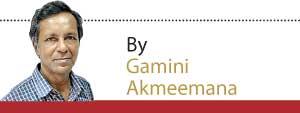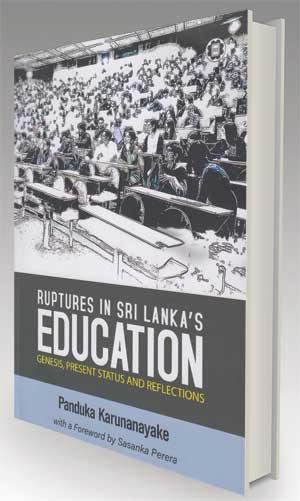A timely, thoughtful book about the education black hole
- Politicians are not brave: they only hide behind an ephemeral façade of popularity. To the extent that a secretly hatched ‘policy’ cannot be a technically sound document, a non-consensual political decision forced down the Opposition’s throat cannot be a sustainable step.
- All in all, this is a timely and highly readable book for those who want to understand Sri Lanka’s crisis in education, at the heart of the country’s development crisis
- To my mind, our subsequent failure as a nation has to do with our own elite’s inability to share power with the masses
Education could well be one of the most discussed but least researched subjects in Sri Lanka. In that context, Prof. Panduka Karunanayake’s ‘Ruptures in Sri Lanka’s Education: Genesis, Present Status and Reflections’ fills a void. It is also highly readable because he delights in debunking myths and exposing fallacies that surrounded the controversial, divisive subject that our education system has become over the years.
2 August 2021
First, a brief introduction of the author is necessary because, despite his illustrious academic record, Prof. Karunanayake is not someone who revels in the public limelight. He is currently a professor in the department of clinical medicine at the University of Colombo, focusing on infectious disease, postgraduate medical education, medical ethics and medical humanities, as well as a former president of the Ceylon College of Physicians, with specialisation in general (internal) medicine.
Prof. Panduka Karunanayake |
He is also a sociologist, and that is why this book is so readable. His language, while not simple, does not get entangled in academic jargon. He begins by offering an invaluable historical perspective of our education system, going back to its origins in the colonial era.
The author writes self-effacingly in his preface that: “Much of what I have said in these essays is, I am afraid, in the form of poorly supported generalizations or what one might call ‘sweeping statements’ – especially from the period 1980s onwards.”
Happily, these ‘sweeping statements’ shed much light on the education mess which, in its extreme manifestations such as the SAITM issue, almost came to terrorism and civil war. Hard truths are beyond popular consumption. Recalling the golden age of our university education, he writes: “Harvard and Oxford were not built in a day. Each generation of scholars did not seek to rebuild them afresh from the start…while Harvard and Oxford have reaped the benefits of centuries of continued existence and gradual growth in their complex environments that were made up of separate, diverse, inter-connected and cross-fertilising entities, our universities seem to stagnate in one place (or even go backwards), reduced to merely celebrating empty, meaning anniversaries and squabbling over each other’s webometric rankings at the bottom of the world table.”
Prof. Karunanayake sounds not so much an exasperated prophet but a sane voice in the wilderness. His despair at the way things have deteriorated over the decades is obvious in every page, but he doesn’t let this overwhelm his task of analysis, and approaches it with the finesse of a surgeon dissecting a moribund case.
Importantly, Prof. Karunanayake meshes his historical perspective with happenings in the UK and Europe, very thoughtful at a time when many Lankans writing on academic subjects simply forget that the outside world exists and that many of our institutions owe their origins to those external sources. For example, when he starts this history with the Colebrooke and Cameron Commission, he gives us its background ranging from the industrial revolution to Charles Dickens.
From the Colombo Academy of 1835 to the University of Ceylon, as the campuses grew in number, they grew in stature, too. Where did we go wrong? The author starts with debunking one deep-rooted fallacy – that Dr. C. W. W. Kannangara’s ‘free education’ reforms’ started the rot. Prof. Karnanayake’s research goes a long away to expose the myths that cloud the Kannangara reforms. As he puts it:
stature, too. Where did we go wrong? The author starts with debunking one deep-rooted fallacy – that Dr. C. W. W. Kannangara’s ‘free education’ reforms’ started the rot. Prof. Karnanayake’s research goes a long away to expose the myths that cloud the Kannangara reforms. As he puts it:
“The objective of the Kannangara reforms was not the provision of non fee levying education or the abolition of fees. That was only one of the strategies. We must start by understanding the objective.”
With his characteristic broad-based approach, the author shows that these reforms came at a time when internationally too, the philosophy of education was going through a momentous transformation, ‘with John Dewey, Bertrand Russel, Rabindranath Tagore and others discovering the potential of science for the emancipation of humanity…”
The author points out that, even before the reforms, 85% of children attended non fee levying schools. For them, this abolition of fees meant nothing. But the latter did not attain English literacy as English-medium instruction was available only to the 15% attending fee levying schools. These got the top government jobs while the latter became, in J. R. Jayawardene’s words, “hewers of wood and drawers of water.”
“In 1939,” says the author, “only rich, male, clever students had the opportunity to do well in life through education. It was this that Dr. Kannangara wished to change. He wished to redistribute this opportunity amongst all clever students – rich and poor, male and female.” But his reforms were not carried through.
The author absolves Dr. Kannangara of blame for the socio-political mayhem post-1956, observing cryptically that as a result Sri Lankan democracy ceased to fit Abraham Lincoln’s description of ‘government of the people, by the people, for the people’ and came to resemble Benjamin Franklin’s description: ‘Two wolves and a lamb deciding what to have for lunch.’
Dr. Kannangara’s reforms had three strategies, and their essence was not non fee levying education ‘but the unshackling of educational opportunity from elitism.’ But the elite undermined these strategies over the next decades by various ploys, such as the underfunding of central colleges (a key factor in the reforms) by denying them science laboratories, and postponing the teaching of English outside of elitist schools. Successive governments exacerbated the damage by chipping away at university autonomy with new legislation.
The author points out other problem areas, such as failing to modify and review national strategies periodically; also, the state failed to metamorphose its role in higher education from being sole provider to being a part-provider-cum regulator, as Japan did in the 1960s. When the elite successfully undermined the first two strategies, the masses responded by hanging onto the third strategy (non fee levying) as it was their only remaining lifeline, compelling Prof. Jayasuriya to conclude that free education was a ‘bonanza for the rich.’
The author insists that, in an era of cross-border education with private universities already here in all but name, ‘the fundamental choice we must make as a nation is between elitism and egalitarianism (the objective), not between fee levying and non fee levying (the strategy). Mindlessly increasing state university intake without safeguarding quality is useless, because it will not create the knowledge workers we seek to create for today’s workforce.’
For those passing the University Grants Commission (UCG) building regularly must be familiar with the sight of riot police, barricades, water cannon and baton charges. The author offers an insight chapter into this dilemma in ‘Egalitarian access to education.’ He starts with a laconic definition of success: “The Holocaust was a success to Hitler, not its victims.”
In this chapter, he raises the question ‘does privatisation move education in the direction of egalitarianism or of elitism?’
The author does not embrace privatisation of education with a carte blanche, and gives what happened during the J. R. Jayewardena era under the stewardship of Dr. Stanley Kalpage as an example. What was achieved then was undone during the R. Premadasa years. The author concludes: “Politicians are not brave: they only hide behind an ephemeral façade of popularity. To the extent that a secretly hatched ‘policy’ cannot be a technically sound document, a non-consensual political decision forced down the Opposition’s throat cannot be a sustainable step. Be warned: We may be repeating history, because we haven’t yet learned from it.”
Prof. Karunanayake discusses other related issues, such as academics’ incomes, and thorny ones such as if the district quota allocation is still needed. He examines vital issues such as promoting research in our universities, the campus as society’s intellectual compass, and argues that Sri Lanka needs university privatisation on the ‘indigenous model.’ All in all, this is a timely and highly readable book for those who want to understand Sri Lanka’s crisis in education, at the heart of the country’s development crisis.
The book is published by Sarasavi Publishers and is priced at Rs. 600.00.
“To my mind, our subsequent failure as a nation has to do with our own elite’s inability to share power with the masses. Education is the great leveller. It can transform, imperceptibly and painlessly, a sleeping, feudal society to a dynamic, modern society. The United States is what it is today because President Lincoln boldly implemented the Morrill Act in the 1860s, and we are what we are today because our elite stealthily undermined the Kannangara reforms of the 1940s. Our nation did not have the skills to share.”



No comments:
Post a Comment
Note: only a member of this blog may post a comment.